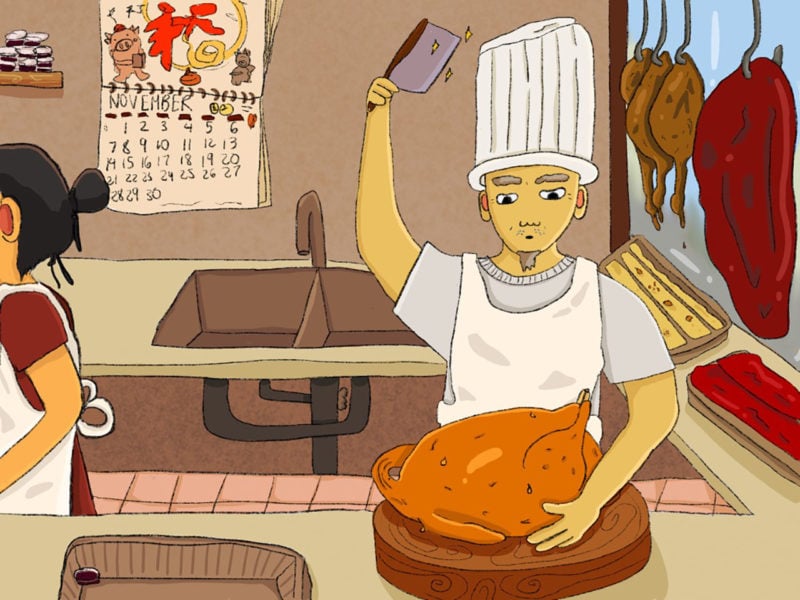Last Updated on November 30, 2021
Illustration by Julianna Eng
Every family has a tried and true way to prepare a Thanksgiving turkey. Some cooks like to flex their culinary chops with a sous vide machine or assemble a turducken, a turkey stuffed with a duck stuffed with a chicken. In my family, we dream about a Thanksgiving turkey that can’t be so easily replicated in a home kitchen. In search of the juiciest and crispiest Thanksgiving bird, we order the roasted turkey from Cheung Hing Restaurant.
A Cantonese Tradition in the States
At any hour of any day throughout the year, diners will shuffle into San Francisco’s famed Cantonese roastery for a quick bite of char siu or siu yuk (two versions of roast pork), or their famous roast duck, which hangs delicately from the ceiling. But those aren’t the only menu items that stir excitement. Come November, these barbecue masters prepare an additional meat for the masses: Giant roast turkeys served with warm gravy.
Cheung Hing belongs to a group of Cantonese roasteries around the country that sell roast turkeys during the Thanksgiving season. Roasting a turkey, with a Cantonese barbecue style known as siu mei, is no small feat. For several days, cooks will meticulously clean, brine, dry, and baste the turkey in a giant oven. Each spot roasts their turkeys with a different recipe, but almost all rely on a technique called inside brining, which helps marinate the turkey as it hangs to dry and gives the skin an extra crispy texture.
Roast Turkeys Get the Special Treatment
Throughout the cooking process, the chefs infuse the meat with a variety of sauces and spices. They add five-spice, hoisin sauce, and star anise to achieve a sweet, savory, and umami flavor. The spices also serve another purpose. Extra juice and spices from the meat collect into a warm gravy that can be drizzled over the turkey or mashed potatoes. Transforming the bird requires many hours of labor, but the delicious crackly skin and juicy meat are well worth the effort: Cheung Hing’s prized roasted turkeys often sell out days before Thanksgiving.
The Backstory of Chinese BBQ
For all its fame today, we can trace the origins of Cantonese barbecue to a period hundreds of years ago. Cantonese roasting traditions originated in the Guangdong province located in southern China. During the Tang and Song dynasties, Guangdong flourished as a trading hub and attracted Arabian and Indian spice traders who contributed new ingredients and flavors to Cantonese barbecue. As Guangdong people refined their barbecue, they opened fully-fledged restaurants across southern China to spotlight their techniques and attract loyal customers.
These eateries were not only delicious but also efficient. Seeking speedy meals, business people and travelers in southern China became the siu mei eateries’ most devoted customers. In the 20th century, Chinese immigrants found new homes in Hong Kong, Singapore, and North America, where they opened up these casual Cantonese roasteries and introduced Cantonese barbecue specialties to new audiences.
—
A Blended Thanksgiving Table
At our Thanksgiving dinners, the Cantonese roast turkey is accompanied by a variety of Cantonese and American sides. My family, inspired by my grandmother’s homestyle Cantonese cooking and Ina Garten’s Thanksgiving specials on Food Network, takes great pride in planning the diverse selection of sides.
Pairing Cantonese and American dishes comes naturally, the same way that Cantonese conversation flows seamlessly with English around the table. Plates brimming with marshmallow yams and cranberry sauce sit right next to bowls of garlicky bok choy and steaming lotus root broth. By the end of the meal, every dish on the table has been licked clean.
No one is more eager to gobble up roast turkey and its sides than my grandmother. She immigrated to the United States in the mid-1900s, arriving with no attachment to the Thanksgiving holiday. Instead, she honored familiar Chinese festivals like Mid-Autumn Festival and Chinese New Year with visits to local siu mei eateries and treated my sister and me to generous servings of soy marinated chicken and roast pork.
Upon discovering Cheung Hing’s roast turkey, my grandmother rejoiced at a centerpiece dish that could blend our family’s distinctly American and Chinese traditions. It’s been a family staple ever since.
Thanksgiving has been celebrated in my multigenerational family for as long as I can remember. The holiday’s history may be less relevant to my family of immigrants, but with a smattering of sides and a plate of delicious Cantonese roast turkey, we have made it uniquely our own.


